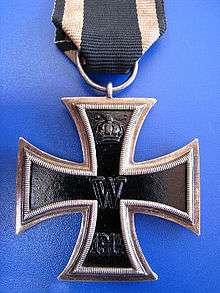Seventh German Inner Africa Research Expedition
The Seventh German Inner Africa Research Expedition (codenamed HIDDEK) was led by German ethnologist and archaeologist Leo Frobenius to Eritrea in 1915. It was a front for a German military espionage mission to Ethiopia, to persuade Emperor Lij Iyasu to support the Central Powers in the First World War and provide assistance to a Mahdist uprising in the Sudan. This could have threatened British and Italian colonies in Eastern Africa and possibly the vital supply route of the Suez Canal.

The expedition is thought to have comprised seventeen persons, five of European descent and twelve of Turkish or Arab origin. The European contingent left Berlin in October 1914 and rendezvoused with the other members in the Ottoman Empire (a German ally). After travelling by rail, cart, camel and dhow to Al Qunfudhah the party boarded a sambuk for the Red Sea crossing to Eritrea. Despite travelling incognito, the party is thought to have been identified by British agents and was intercepted by four British and French vessels but allowed on its way. The Italian authorities became aware of the expedition and it was abandoned after it was made public in discussions in the Italian parliament. Negotiations between the Italians, French and British resulted in safe passage for the expedition members who returned to Italy and the Ottoman Empire.
Despite not entering Ethiopia, Frobenius heralded the expedition as a success and campaigned for the right to lead a follow-up expedition. This was instead led by Friedrich Salomon Hall, who had taken part in Frobenius' expedition. Iyasu lent his support to the Mahdists and burnt down several Italian radio stations but was ousted in a British-supported coup that brought Haile Selassie to power. Frobenius continued his expeditions after the war but found it difficult to gain entry to British-controlled territories due to his involvement in espionage.
Background
Leo Frobenius was a self-taught German ethnologist and archaeologist who specialised in African cultures.[1] He led twelve German Inner Africa Research Expeditions (Deutsche Innerafrikanische Forschungs-Expeditions, DIAFE) to Africa between 1904 and 1935.[2] His work in the field has been described as epic and pioneering and is of considerable documentary value.[3][4] His conclusions on the development of African civilisation from non-African origins were controversial and are not supported by modern writers.[3] He has also been accused of using the expeditions to loot items of cultural value from Africa.[5]
Strategic aims
.png)
At the outbreak of the First World War in 1914, Frobenius was regarded as the foremost German expert on Africa; he was a close friend of Kaiser Wilhelm II and often corresponded with him.[1] Oberste Heeresleitung, the German high command, were keen to secure the entry of Ethiopia into the war on the side of the Central Powers. They hoped that this would "force the enemy to commit large forces in defending their colonies in the Horn of Africa, thus weakening their European front and relieving the German forces fighting in German East Africa" or else secure the withdrawal of Italian and French troops from their colonies.[6] Germany was suspicious of the true allegiance of Italy, formally a member of the Central Powers but with close ties to the Entente Powers; and Ethiopian troops would be in prime position to occupy Italian Eritrea if the need arose.[7] The Germans were also hopeful of instigating a Mahdist uprising in Anglo-Egyptian Sudan and an alliance between the Ethiopian emperor Lij Iyasu and the Mohammed Abdullah Hassan (known to some as the "Mad Mullah").[1][8] The Germans believed that an uprising would threaten the Suez Canal and could inspire jihad against the British across Northern Africa and the Middle East.[1][7][9]
The German legation in Ethiopia was out of communication with their superiors in Berlin as the country was surrounded by territories of the Entente and Eritrea.[1] Messages had to be passed in cipher via disguised couriers through Italian Eritrea, over the Red Sea and through Arabia.[7] The Germans planned an expedition to Ethiopia which would restore communications and advance their objectives for Ethiopia and Sudan.[1] It was decided that this expedition would publicly be called scientific to disguise its military and political aims.[7] Frobenius offered his services as leader of the expedition to the Kaiser on 13 November 1914, who directed that the expedition should proceed.[7] The expedition would form the seventh of Frobenius' Deutsche Innerafrikanische Forschungs-Expeditions (German Inner-Africa Research Expeditions), though some sources incorrectly refer to it as his fourth expedition.[10] In German intelligence circles it was codenamed HIDDEK, an acronym for Die Hauptsache ist, daß England untergeht (The main thing is that England is destroyed).[7]
Planning
Frobenius had visited Sudan during his 1912 expedition but had no experience in Eritrea or Ethiopia and spoke none of the local languages.[1] His plan was to carry mail to the legation, meet with Ethiopian politicians to secure their support for the German cause, proceed to Sudan to persuade the population to rise up and to strengthen links between the Ottoman Empire and the Muslim inhabitants of Sudan, Danakil, Somalia, Libya and Ethiopia.[7] The expedition was fairly cheap owing to the use of equipment from Frobenius' previous expeditions and had funding of 60,000 German marks in a mixture of hard currencies including marks, Ottoman piastres, Austro-Hungarian Maria Theresa Thaler and Italian Lira.[7][8] The German government also provided a quantity of weapons and ammunition.[7] The Ottoman Empire was invited to join the expedition and accepted, hoping to return Egypt to their control.[8] In advance of the expedition the Ottomans made diplomatic concessions to Ethiopia by returning ownership of a number of monastic properties in Jerusalem.[9]

The members of the expedition are disputed but are thought to have numbered around seventeen: five Europeans and twelve Turks or Arabs.[7] The European members were Frobenius, ethnographer Albrecht Martius, photographer Robert Türstig, foreign office official Hieronymus Kistenfeger and interpreter Mario Passarge.[7] Amongst the other members was Bekir Sami Kunduh, the former governor of Libya and a future Turkish foreign minister and Friedrich Salomon Hall, a German citizen of Abyssinian origin. Hall was to negotiate the entry of Ethiopia into the war and he had originally been intended to lead an earlier expedition with a similar aim.[7]
Frobenius is known to have valued titles and before setting out on the expedition insisted that he was granted various honours.[8] The German Empire awarded him the title of Geheimrat (Privy Councillor) and Resident at Darfur, and Plenipotentiary of His Imperial Ottoman Majesty in Arabia.[7][8] He was also appointed a Pasha of the Ottoman Empire, which he appended to his Arab name "Abdul Kerim".[7][8] By 1915, the Ottomans had grown frustrated with Frobenius and the German ambassador reported to Berlin that "the Turkish government has become extremely sensitive by our various expeditions, especially that of Frobenius [which] has earned the biggest mistrust".[7]
Journey to Africa

The expedition left Berlin in early October 1914 and travelled via Austria, Romania and Bulgaria to reach Constantinople, capital of the Ottoman Empire, on 21 November. They left the city on 24 December and travelled via the Chemins de fer Ottomans d'Anatolie and Berlin–Baghdad railway, horse-drawn cart and camel through Aleppo to Damascus, Syria which they reached on 5 January. The party resided at the Hotel Victoria whilst the full complement of European staff was gathered.[7]
The expedition travelled from Damascus via the Hejaz railway to Jaffa in Palestine, where many of the Ottoman contingent were recruited. The party continued by rail to Al-`Ula in north-western Arabia, arriving on 15 January 1915. They travelled south by Bedouin camel to Al Wajh on the coast of the Red Sea. Frobenius made careful assessments of the political condition of the regions he travelled through and reported to Berlin of the weakness of Ottoman forces in the area, the unpopularity of their Tripoli-born officials and the poverty and hunger caused by the British blockade. He also noted poverty caused by the war preventing Hajj pilgrims coming from British and French-controlled territory and success that the British were having in buying Arab loyalty with food shipments.[7]

The expedition left Al Wajh on 24 January and proceeded via dhow to Al Qunfudhah, arriving on 7 February.[7] Here many of the expedition disguised themselves in Arab robes and posed as smugglers of animal hides; the Palestinian Arabs in the party were disguised as gardeners.[7][8][11] Türstig masqueraded as an official of the Red Cross and his eighty packs of photographic equipment were disguised as hospital supplies.[7] On 13 February the expedition boarded a sambuk to make the crossing of the Red Sea to Africa.[7]

The sambuk was intercepted on its first day of travel by the armed merchant cruiser HMS Empress of Russia at the Farasan Islands. Frobenius suspected that his movements in Arabia had been monitored by British agents. The vessel was allowed to proceed on its way until later that day when she was again brought to inspection by the French cruiser Desaix.[7] The crew of the sambuk distracted the French sailors by trying to sell postcards to them whilst Frobenius' men used a toilet to enter the boat's sanitary tank.[11] The expedition escaped detection and even managed to take a photograph of the Desaix through a crack in the sambuk's hull.[7][11] The sambuk was stopped and inspected twice more by British vessels near Al Hudaydah and was again allowed to proceed on her journey.[7]
The sambuk docked at Massawa in Italian Eritrea on 15 February 1915. It is thought that the British intelligence services had tipped off the Italians about the expedition as early as February 1915 and the party received a cold reception from the Italian authorities. Suspicions were later raised that Passarge, Frobenius' interpreter, who held dual Italian and German citizenship and was a close friend of Carmine Senise (a high-ranking official in the Italian intelligence agency), may have been a double agent.[7] Frobenius compromised the expedition by introducing himself in Massawa as a military captain.[12]
Discovery
At Massawa the expedition members took part in hunting, other social activities and made visits to Zazega (near Asmara), Maji Malehesh, Lamdrara and Dembe Wadi Mudui to view rock engravings, of which 37 sketches were made.[7] Compared to his previous expeditions, scientific output was much less, rather than thousands of photographs, the seventh expedition has fewer than one hundred.[13]
.jpg)
Some of the expedition members took rooms on board the Hamburg-American Packet Company vessel Christian X. The Italian chief of civil affairs in the town had the vessel monitored and was disturbed to find that Frobenius had bought an Italian flag (for use as a false flag), had purchased maps of the coastline and was making trips to identify potential landing sites. Frobenius also made contact with Bernhard von Bülow of the Foreign Office in Berlin to obtain diplomatic bags to carry mail to the German Legation in Addis Ababa.[7]
The presence of Frobenius in Eritrea was a threat to Italian neutrality but expelling him would also jeopardise it. The discovery of pro-jihadi leaflets in Frobenius' possession provided a convenient pretext. News of the leaflets was passed to the Italian parliament and soon after it was made public, Bülow made an appeal to the Italians to grant Frobenius safe passage to Germany. Lengthy negotiations between the British, French and Italian governments eventually resulted in an agreement, with the British foreign secretary Edward Grey happy to provide safe conduct to Frobenius in recognition of the work done to thwart his mission by the Italians.[7] The expedition left Massawa on 26 March. The European members were given passage aboard a postal vessel, the Adalia, for Port Said (in British Egypt) and the Arab and Turkish members boarded the Italian ship Montenegro for Jaffa and onward travel to Jerusalem where they arrived on 6 April.[7]
Aftermath
From Port Said the European members of the party travelled on to Naples, Italy where they arrived in April 1915. Türstig accompanied the expedition's equipment and the remaining ℳ 2,250.50 back to Germany via Genoa whilst the rest of the members travelled to Rome to meet with Bülow.[7] The German consul in Naples tried to downplay the affair, claiming that Frobenius had acted only as a messenger to the legation in Addis Ababa, and Frobenius took part in several interviews with La Tribuna and press agencies to deny espionage and to play down the military background of his party.[7][12] He later admitted his aim had been "to influence the Arab countries on behalf of the Ottoman government", admitted to military espionage and campaigned to be awarded a medal from the Italian authorities.[7][11] Frobenius' indiscretion caused the German embassy some difficulties and he was sent back to Germany on 9 April, crossing the Austrian border shortly before Italy declared its intention to enter the war on the Allied side.[7] Frobenius' lack of secrecy throughout the expedition has been named as a contributing factor to its failure.[13]

In Berlin Frobenius presented the mission as a success, claiming to have made important contacts in the area and was awarded the Iron Cross 2nd Class.[12][13] The failure seems to have caused no harm to his political or scientific standing in Germany.[12] Frobenius proposed that he be dispatched immediately to lead a second expedition with the same aims. This request was denied and he was instead appointed to command a prisoner of war camp housing captured African and Indian soldiers.[13] Frobenius spent the rest of the war consolidating his research from previous expeditions and cataloguing the artefacts he had collected.[14] He published only one paper from his seventh expedition, a rough outline of Eritrean architecture.[15]
A follow-up expedition was sent in June 1915 under command of Salomon Hall but he was captured by the Italian police whilst in disguise as a local. Hall managed to get documents passed to the German legation, which promised the Ethiopians a port on the Red Sea and any territory captured from the Allies. Emperor Lij Iyasu sent weapons to the "Mad Mullah" and destroyed Italian radio stations but was deposed in 1916 after his excommunication by the Ethiopian Orthodox Church, which feared he had converted to Islam.[6][13] The overthrow of Iyasu is thought to have been orchestrated by the Allies and brought Haile Selassie to power.[6]
Frobenius founded the Institute for the Morphology of Culture in Frankfurt in 1920, later the Frobenius Institute of anthropology and became professor of ethnology at University of Frankfurt.[14] He was keen to continue his expeditions into Africa after the war but found travel was more difficult now he was known to the British intelligence services.[7][13] Frobenius' expedition to Sudan in 1926 was affected by a British refusal to grant him access to Khartoum and a proposed expedition to Rhodesia in 1927 had to be cancelled after he was blacklisted from travelling to the British colony.[7][13] The final expedition he led to Africa (Libya 1933) was closely monitored by the Italian authorities.[7] Frobenius looked further afield and led expeditions to New Guinea and Australia in 1937–38, before his death in August 1938.[16]
References
- Schmidt, Wolbert; Thubauville, Sophia (2015). Cultural Research in Northeast Africa: German Histories and Stories. Frankfurt: Frobenius-Institut. p. 173.
- Westphal-Hellbusch, Sigrid (October 1959). "The Present Situation of Ethnological Research in Germany". American Anthropologist. 61 (5): 850. doi:10.1525/aa.1959.61.5.02a00110. ISSN 0002-7294.
- Wintjes, Justine (November 2013). "The Frobenius expedition to Natal and the Cinyati archive". Southern African Humanities: 167. Retrieved 6 July 2019.
- Wintjes, Justine (November 2013). "The Frobenius expedition to Natal and the Cinyati archive". Southern African Humanities: 168. Retrieved 6 July 2019.
- Wintjes, Justine (November 2013). "The Frobenius expedition to Natal and the Cinyati archive". Southern African Humanities: 170. Retrieved 6 July 2019.
- "Ethiopian prince who scuppered Germany's WW1 plans". BBC News. 25 September 2016. Retrieved 6 July 2019.
- Da Riva, Rocío; Biocca, Dario (5 August 2016). "Leo Frobenius' Secret Mission in Arabia and Eritrea (1914–1915)". Arabian Humanities. Revue internationale d'archéologie et de sciences sociales sur la péninsule Arabique/International Journal of Archaeology and Social Sciences in the Arabian Peninsula (in French) (6). doi:10.4000/cy.3099. ISSN 1248-0568. Retrieved 25 February 2019.
- Schmidt, Wolbert; Thubauville, Sophia (2015). Cultural Research in Northeast Africa: German Histories and Stories. Frankfurt: Frobenius-Institut. p. 174.
- Shinn, David H.; Ofcansky, Thomas P. (2013). Historical Dictionary of Ethiopia. Scarecrow Press. p. 424. ISBN 978-0-8108-7457-2.
- "Expeditions - Frobenius-Institut Frankfurt am Main". www.frobenius-institut.de. Frobenius Institute. Retrieved 28 February 2017.
- Fisk, Robert (7 November 2009). "The German Lawrence of Arabia had much to live up". The Independent. Retrieved 6 July 2019.
- Schmidt, Wolbert; Thubauville, Sophia (2015). Cultural Research in Northeast Africa: German Histories and Stories. Frankfurt: Frobenius-Institut. p. 176.
- Schmidt, Wolbert; Thubauville, Sophia (2015). Cultural Research in Northeast Africa: German Histories and Stories. Frankfurt: Frobenius-Institut. p. 177.
- Magill, Frank M., ed. (13 May 2011). The 20th Century A-GI: Dictionary of World Biography. VII. Abingdon, Oxfordshire: Routledge. p. 1,243. ISBN 978-1-57958-046-9. Retrieved 3 October 2016.
- Schmidt, Wolbert; Thubauville, Sophia (2015). Cultural Research in Northeast Africa: German Histories and Stories. Frankfurt: Frobenius-Institut. p. 179.
- Haller, Dieter (2012). Die Suche nach dem Fremden: Geschichte der Ethnologie in der Bundesrepublik 1945–1990 (in German). Campus Verlag. p. 156. ISBN 978-3-593-39600-2. Retrieved 1 July 2019.